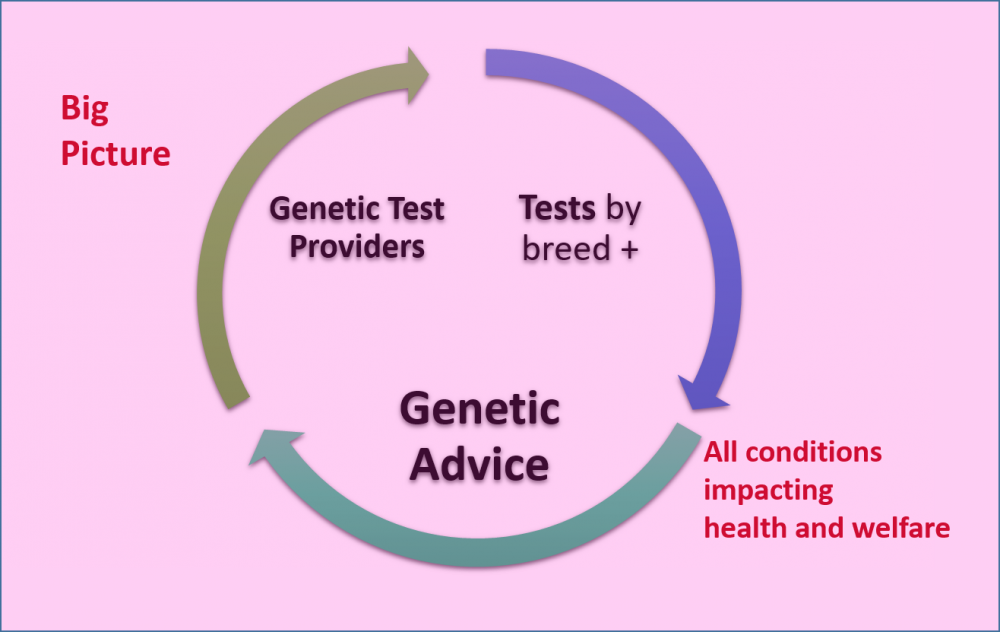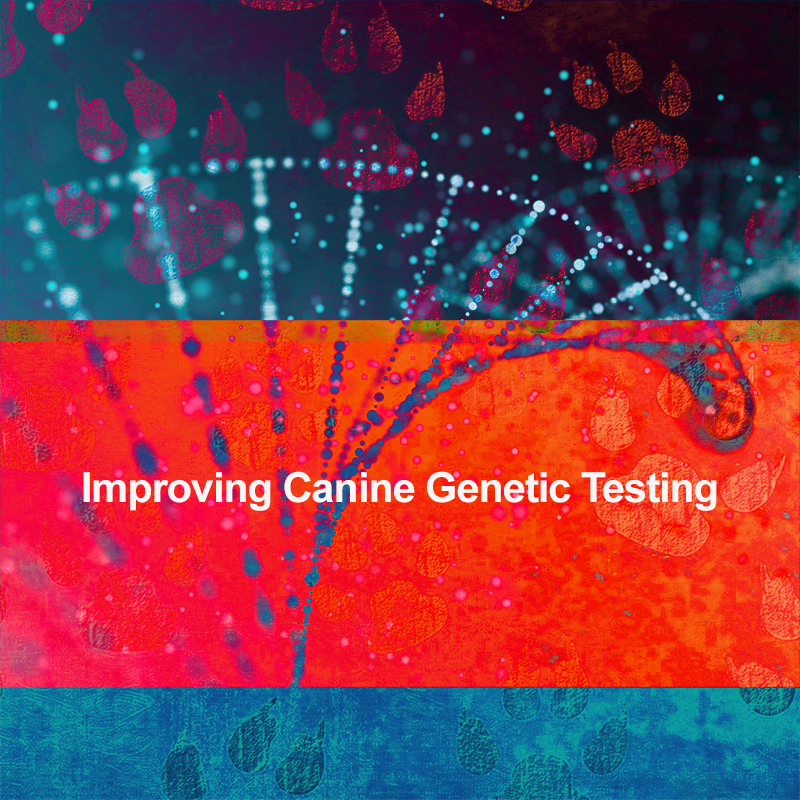Several recent articles have raised concerns about the quality of canine genetic testing. There is concern about the quality measures, standards and practices of genetic test providers (GTPs), but there are also factors related to test discovery, validation and application that may limit our ability to get the most out of genetic testing. Confusion, lack of transparency, absence of needed information on many levels, and incomplete understanding of the situations, individuals and breeds where testing is most useful are among the challenges. This article is in response to numerous queries and discussions on what is needed to improve the situation.
 Standards and guidelines for canine clinical genetic testing laboratories
Standards and guidelines for canine clinical genetic testing laboratories
Shaffer, L.G., Sundin, K., Geretschlaeger, A. et al. Hum Genet (2018). https://doi.org/10.1007/s00439-018-1954-4
A recent comprehensive paper by Shaffer, et al. is modeled on guidelines for human labs and on the premise that there is no reason to expect less quality from companies providing similar analyses on canine samples. The authors are to be commended for putting these suggestions into the literature. As the authors have suggested, animal labs can certainly use the accompanying resources / checklist as part of a self-evaluation for quality improvement. Hopefully this paper will prompt discussions on whether the authors’ guidelines reflect a minimum necessary standard. However, at the moment - or really on the horizon - there is no body or organization in a position to implement these requirements, evaluate labs, or regulate.
The IPFD Harmonization of Genetic Testing (HGTD) is providing transparency in terms of which genetic test providers (GTPs) are willing to participate and at least be open as to what quality measures they have in place (See Dec 2018 Update). This resource has already begun to impact kennel club policy, with the French Kennel club adding a new requirement that only test results from participating GTPs will be entered into their official records; hopefully others will follow their lead. Although this does not ensure that the results are perfect, it is a step in the right direction.
From the HGTD work, our sense is that relatively few labs would be able to meet all the proposed requirements/ standards. The call for, e.g. accreditation, etc., may be a focus for commercial labs, but some key canine genetic tests are sold by the academic labs who discovered them and who may have the best knowledge of the research and test particulars; this adds a layer of complexity. Associated with universities or research institutions, these GTPs are diverse in their organization, procedures, people, expertise of staff, etc. but they might generally not be in a position to satisfy human-testing criteria. On a purely practical level, it seems unlikely that most companion animal testing facilities would find it possible to implement all the recommendations. This is not to suggest that the reality that canine GTPs might not meet exacting standards excuses them from achieving a reasonable level of quality assurance; but there may still be questions as to what is an acceptable level. There are no doubt some ‘poor’ GTPs out there (commercial and otherwise) just as it is possible that some labs are doing accurate testing, at least in general, even without all these quality measures in place. The challenge is to know the good or adequate from the less so.
The discussion that needs to go forward is whether the suggested parameters (or which of them) are truly needed; if the Shaffer paper has nailed down the minimum standards, and those are to be followed, we will likely end up with a canine genetic testing landscape with many fewer GTPs and higher costs to the consumer. Would be a good thing? Possibly, but would there be other less-desirable side effects?
Lab standards are only the tip of the iceberg...
Notwithstanding important concerns about the parameters for quality labs laid out in the paper, there are many underlying problems related to testing that might be equally or more impactful on the validity and appropriate application of testing in dogs. For example:
-
Relatively few tests have been fully validated across all the breeds for which they are offered, and almost none across different populations of breeds (e.g. geographically diverse). For some conditions this is less of a concern, for others it is a crucial limitation.
-
Tests are often marketed in advance of peer review on even basic discovery. The excuse is made that it is important to get the test out to the breeders as soon as possible. Unfortunately, without scientific oversight we will end up with more and more tests with questionable or unknown validity and then unknown long term impacts.
-
Tests are the subject of social media storms and may be commercially viable even in the absence of validating information. Nobody thinks ‘decision-making by Facebook’ is a rational approach to health strategies in dogs, but it is an unfortunate reality.
The IPFD HGTD development was planned to include a proficiency testing component. Unfortunately, this has not been able to move forward as planned, as the lab who had hoped to develop and coordinate it has lacked the resources to do so. A major challenge to imagining a proficiency testing program to help weed out ‘poor’ GTPS is that it would have to move forward not only on a test-by-test basis but, for some tests, also by test and breed. There is no easy solution for across the board proficiency testing in dogs.
 Because of all the preceding, and for other reasons, testing to inform breeding decisions often happens without consideration of the importance of the test/ condition in a given breed relative to other conditions that may be more common, more severe, etc. At IPFD we are working on a parallel development – the Health Strategies Database for Dogs that will help kennel and breed clubs, veterinarians and others provide information by breed and location as to the comprehensive list of conditions of concern within a breed and suggested health strategies. We should of course use genetic testing as appropriate, but this should not be seen as a ’silver bullet’ or distract us from a broad consideration of concerns within a breed.
Because of all the preceding, and for other reasons, testing to inform breeding decisions often happens without consideration of the importance of the test/ condition in a given breed relative to other conditions that may be more common, more severe, etc. At IPFD we are working on a parallel development – the Health Strategies Database for Dogs that will help kennel and breed clubs, veterinarians and others provide information by breed and location as to the comprehensive list of conditions of concern within a breed and suggested health strategies. We should of course use genetic testing as appropriate, but this should not be seen as a ’silver bullet’ or distract us from a broad consideration of concerns within a breed.
The ‘big picture’ on what tests are important is complicated by the fact that much research in dogs is targeted at conditions that might be similar to those in humans; funding for purely dog- or breed-relevant research is currently challenging to find. Discovery-focused researchers may not be willing or able to take on the responsibility or priority to consider the wider impact of their findings. In fairness, the information needed to define those issues may also be lacking.
It is impossible to say which is the greatest challenge at the moment - false or inaccurate test results (poor lab quality) vs. inappropriate or premature use of tests (on a condition X breed basis) vs. applying tests in breeds where validation is not available vs. veterinarians and/or clients not being entirely sure which tests to order or how to interpret them (as raised in a recent Nature commentary, see below) vs. breeders demanding 'clear/ negative' results for all breeding animals for conditions where using carriers is perfectly safe given appropriate precautions are taken.... or .... or? We have recently had prompting from both breeders and experts on challenges posed by, e.g. degenerative myelopathy tests being sold / promoted to breeds where the test is either unvalidated and/or likely not appropriate for use in that breed; and several other tests for which there is no peer review of even the discovery phase. Within the HGTD we will soon be adding Expert Panel discussions to address some of these issues.
The challenges are many and complex and there is no simple solution. The Shaffer paper provides one approach and its merits should be carefully considered. And, notwithstanding concerns about interpretation, we must have confidence that we have accurate test results. I am recently in touch with a group of veterinary geneticists who are looking for a way forward to evaluate tests (by test and by breed) with a goal of achieving something like the ClinGen initiative in humans. This initiative curates available genes / tests and uses the term ‘actionability’ to describe the level of evidence that a ‘gene-condition pair’ is important.
As we said in our response to the Nature paper, and based on our experience, we need a balanced approach to achieve reasonable quality, appropriate applications and support for owners, breeders and veterinarians as well as genetic counselors. We must first and foremost achieve the best we can - right now - for the overall health and welfare of both individual dogs and breeds as we ensure that we do not lose the potential for new technologies to appropriately inform our efforts.
Also see: Genetics and Genomics for Dogs: Balancing daunting challenges and great potential
 Donate
Donate


Recommended Comments
Join the conversation
You can post now and register later. If you have an account, sign in now to post with your account.
Note: Your post will require moderator approval before it will be visible.